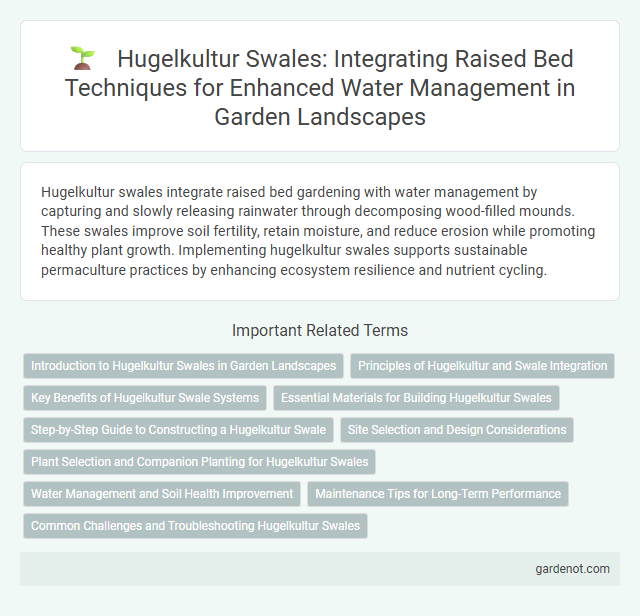Hugelkultur swales integrate raised bed gardening with water management by capturing and slowly releasing rainwater through decomposing wood-filled mounds. These swales improve soil fertility, retain moisture, and reduce erosion while promoting healthy plant growth. Implementing hugelkultur swales supports sustainable permaculture practices by enhancing ecosystem resilience and nutrient cycling.
Introduction to Hugelkultur Swales in Garden Landscapes
Hugelkultur swales integrate raised garden beds with swale trenches to optimize water retention and soil fertility in permaculture landscapes. These structures capture and slowly release rainwater, reducing runoff and supporting deep-rooted plants by enhancing moisture availability. Utilizing decomposing wood and organic matter, hugelkultur swales improve soil structure and nutrient cycling, fostering resilient garden ecosystems.
Principles of Hugelkultur and Swale Integration
Hugelkultur swale combines the principles of raised bed gardening with water-retention earthworks, maximizing soil fertility and moisture conservation. By integrating decaying wood and organic matter into swale structures, this technique enhances microbial activity and nutrient cycling, improving plant growth in drought-prone areas. The synergy between hugelkultur mounds and swales creates a self-sustaining ecosystem that captures runoff, reduces erosion, and promotes long-term soil health.
Key Benefits of Hugelkultur Swale Systems
Hugelkultur swale systems enhance water retention by capturing and slowly releasing moisture throughout the growing season, reducing irrigation needs and preventing soil erosion. They improve soil fertility through the gradual decomposition of buried wood and organic matter, fostering nutrient-rich environments for plant roots. These systems promote biodiversity by creating varied microhabitats, supporting beneficial microbes, insects, and vegetation diversity.
Essential Materials for Building Hugelkultur Swales
Essential materials for building Hugelkultur swales include decomposing wood, such as logs, branches, and twigs, which provide long-lasting organic matter and improve soil fertility. Layering nutrient-rich compost, rich topsoil, and mulch enhances moisture retention and accelerates nutrient cycling within the swale. Incorporating natural stones or logs to form swale borders optimizes water flow and soil erosion control in permaculture design.
Step-by-Step Guide to Constructing a Hugelkultur Swale
Hugelkultur swale construction begins by marking a contour line on the slope to ensure water retention follows the natural landscape. Dig a swale trench along this contour, then fill it with decaying wood, branches, leaves, and compost to build the hugelkultur mound that gradually decomposes and retains moisture. Finally, cover the mound with topsoil and plant native vegetation to stabilize the soil, enhance water absorption, and promote ecological health.
Site Selection and Design Considerations
Hugelkultur swales should be located on gentle slopes with well-draining soil to maximize water retention and infiltration. Design considerations include the size and orientation of the swale to capture runoff efficiently, using decomposing woody debris as the base layer to enhance soil fertility and moisture retention. Proper siting away from flood-prone areas ensures long-term stability and prevents erosion.
Plant Selection and Companion Planting for Hugelkultur Swales
Selecting drought-tolerant, deep-rooted plants such as comfrey, yarrow, and native grasses enhances soil aeration and nutrient cycling in Hugelkultur swales. Companion planting with nitrogen-fixers like clover and legumes improves soil fertility, while dynamic accumulators such as comfrey draw essential minerals from deeper soil layers for nearby crops. Incorporating diverse plant species supports microbial activity, controls erosion, and maximizes water retention in the swale ecosystem.
Water Management and Soil Health Improvement
Hugelkultur swales enhance water management by capturing and slowly releasing rainwater, reducing runoff and promoting deep soil moisture retention. These earthworks integrate decomposing wood and organic matter, enriching soil structure and nutrient availability over time. The combination supports sustainable irrigation and boosts microbial activity, leading to improved soil health and plant growth.
Maintenance Tips for Long-Term Performance
Hugelkultur swales require regular inspection to prevent clogging and maintain optimal water infiltration by removing debris and dead plant material. Mulching with organic matter helps preserve soil moisture and supports beneficial microbial activity critical for soil health. Pruning overgrown vegetation and repairing any erosion ensure sustained structural integrity and long-term performance of the swale system.
Common Challenges and Troubleshooting Hugelkultur Swales
Hugelkultur swales often face challenges such as uneven water distribution, leading to dry spots or waterlogging that impede plant growth. Troubleshooting methods include adjusting the swale's slope, adding mulch to retain moisture, and incorporating additional soil layers to improve drainage and nutrient availability. Regular monitoring for erosion and soil compaction helps maintain swale functionality and promotes healthy ecosystem development.
Hügelkultur swale Infographic

 gardenot.com
gardenot.com